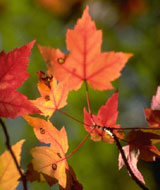 Leaves
change color in the fall, because the chemical changes in the leaves,
as their nutrients drain into the tree's branches, trunk, and roots
for winter storage, cause the leaves to stop producing the green pigment
chlorophyll. Leaves
change color in the fall, because the chemical changes in the leaves,
as their nutrients drain into the tree's branches, trunk, and roots
for winter storage, cause the leaves to stop producing the green pigment
chlorophyll.
Chlorophyll's role in the leaves, to absorb sunlight and to use
the sun's energy, is no longer necessary, and the remaining chlorophyll
in the leaves disintegrates.
When the pigment chlorophyll departs, secondary pigments, substances
that also absorb light, emerge to take its place, and change the
leaves' colors to theirs. For example, yellow and orange leaves
contain the pigment carotene, the
same pigment that gives carrots their bright orange color.
Red, wine-red, and purple leaves contain the pigments anthocyanins,
which also lend their color to radishes,
cabbage, roses, and geraniums. The
main difference between carotene and anthrocyanins is that the anthrocyanins
only form in the leaves in the fall when the weather becomes cooler,
especially when the temperature falls to between 32 degrees to 45
degrees Fahrenheit.
One characteristic of the leaves' color is that, for the most part,
it is inherited. The variations in the color, however, are determined
by weather conditions. The richest and most brilliant foliage appears
after weeks of cool, sunny weather in places in the United States
such as New England.
The color of the leaves fade as fall turns to winter, and the stems
that secure them to the branches begin to loosen with the change
in weather. The cells at the ends of the stems fall apart, leaving
the leaves attached to the branches by the thin
veins that, in warmer weather, transported water and nutrients
to the leaves. At this point, virtually any movement can break the
veins and the leaves tumble to the ground.
Although the yellow and red pigments last for a few days once on
the ground, they soon disintegrate just as the green chlorophyll
pigment did. All that remains are brown leaves colored by tannins,
which also give tea its brown color. Without a water supply, the
brown leaves carpeting the ground become dry and brittle, and the
trees bare.
|
|
note:
|
pigment: 色素
chlorophyll: 叶绿素
disintegrate: 分解
carotene: 胡萝卜素
anthocyanins: 花青素
radish: 萝卜
geraniums:
天竺葵
vein: 纹理
tannis: 单宁酸
|
|
